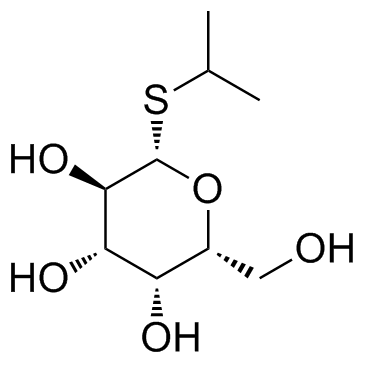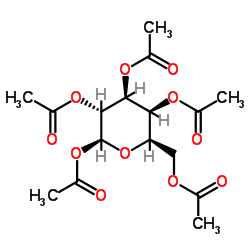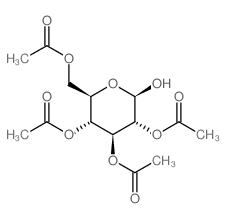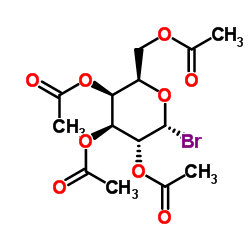Isopropyl-beta-D-thiogalactopyranoside

Isopropyl-beta-D-thiogalactopyranoside structure
|
Common Name | Isopropyl-beta-D-thiogalactopyranoside | ||
|---|---|---|---|---|
| CAS Number | 367-93-1 | Molecular Weight | 238.301 | |
| Density | 1.4±0.1 g/cm3 | Boiling Point | 438.4±45.0 °C at 760 mmHg | |
| Molecular Formula | C9H18O5S | Melting Point | 105 °C | |
| MSDS | USA | Flash Point | 218.9±28.7 °C | |
| Symbol |


GHS07, GHS08 |
Signal Word | Warning | |
Use of Isopropyl-beta-D-thiogalactopyranosideIPTG is a molecular mimic of allolactose, a lactose metabolite that triggers transcription of the lac operon, and it is therefore used to induce protein expression where the gene is under the control of the lac operator. |
| Name | isopropyl β-D-thiogalactopyranoside |
|---|---|
| Synonym | More Synonyms |
| Description | IPTG is a molecular mimic of allolactose, a lactose metabolite that triggers transcription of the lac operon, and it is therefore used to induce protein expression where the gene is under the control of the lac operator. |
|---|---|
| Related Catalog | |
| In Vitro | IPTG uptake by E. coli can be independent of the action of lactose permease, since other transport pathways are also involved. At low concentration, IPTG enters cells through lactose permease, but at high concentrations (typically used for protein induction), IPTG can enter the cells independently of lactose permease[1]. |
| References |
| Density | 1.4±0.1 g/cm3 |
|---|---|
| Boiling Point | 438.4±45.0 °C at 760 mmHg |
| Melting Point | 105 °C |
| Molecular Formula | C9H18O5S |
| Molecular Weight | 238.301 |
| Flash Point | 218.9±28.7 °C |
| Exact Mass | 238.087494 |
| PSA | 115.45000 |
| LogP | -1.01 |
| Vapour Pressure | 0.0±2.4 mmHg at 25°C |
| Index of Refraction | 1.578 |
| Water Solubility | soluble |
| Symbol |


GHS07, GHS08 |
|---|---|
| Signal Word | Warning |
| Hazard Statements | H319-H351 |
| Precautionary Statements | P281-P305 + P351 + P338 |
| Personal Protective Equipment | Eyeshields;Gloves;half-mask respirator (US);multi-purpose combination respirator cartridge (US) |
| Hazard Codes | Xn:Harmful |
| Risk Phrases | R19;R40;R66 |
| Safety Phrases | S23-S24/25-S36/37-S22 |
| RIDADR | NONH for all modes of transport |
| WGK Germany | 3 |
| HS Code | 2932999099 |
|
~89% 
Isopropyl-beta-... CAS#:367-93-1 |
| Literature: Schmidt, Richard R.; Stumpp, Michael Liebigs Annalen der Chemie, 1983 , # 7 p. 1249 - 1256 |
|
~% 
Isopropyl-beta-... CAS#:367-93-1 |
| Literature: Li, Aixiao; Kong, Fanzuo Bioorganic and Medicinal Chemistry, 2005 , vol. 13, # 3 p. 839 - 853 |
|
~% 
Isopropyl-beta-... CAS#:367-93-1 |
| Literature: Thiem, Joachim; Wiesner, Matthias Carbohydrate Research, 1993 , vol. 249, # 1 p. 197 - 206 |
|
~% 
Isopropyl-beta-... CAS#:367-93-1 |
| Literature: Schmidt, Richard R.; Stumpp, Michael Liebigs Annalen der Chemie, 1983 , # 7 p. 1249 - 1256 |
|
~% 
Isopropyl-beta-... CAS#:367-93-1 |
| Literature: Helferich; Tuerk Chemische Berichte, 1956 , vol. 89, p. 2215,2218 |
| HS Code | 2932999099 |
|---|---|
| Summary | 2932999099. other heterocyclic compounds with oxygen hetero-atom(s) only. VAT:17.0%. Tax rebate rate:13.0%. . MFN tariff:6.5%. General tariff:20.0% |
|
A survey of the interactome of Kaposi's sarcoma-associated herpesvirus ORF45 revealed its binding to viral ORF33 and cellular USP7, resulting in stabilization of ORF33 that is required for production of progeny viruses.
J. Virol. 89(9) , 4918-31, (2015) The ORF45 protein of Kaposi's sarcoma-associated herpesvirus (KSHV) is a gammaherpesvirus-specific immediate-early tegument protein. Our previous studies have revealed its crucial roles in both early ... |
|
|
Phospho-tyrosine dependent protein-protein interaction network.
Mol. Syst. Biol. 11(3) , 794, (2015) Post-translational protein modifications, such as tyrosine phosphorylation, regulate protein-protein interactions (PPIs) critical for signal processing and cellular phenotypes. We extended an establis... |
|
|
An HD-domain phosphodiesterase mediates cooperative hydrolysis of c-di-AMP to affect bacterial growth and virulence.
Proc. Natl. Acad. Sci. U. S. A. 112(7) , E747-56, (2015) The nucleotide cyclic di-3',5'- adenosine monophosphate (c-di-AMP) was recently identified as an essential and widespread second messenger in bacterial signaling. Among c-di-AMP-producing bacteria, al... |
| MFCD00063273 |
| isopropyl beta-D-thiogalactopyranoside |
| Isopropyl-b-D-thiogalactopyranoside |
| UNII-X73VV2246B |
| (2R,3R,4S,5R,6S)-2-(hydroxymethyl)-6-propan-2-ylsulfanyloxane-3,4,5-triol |
| Isopropyl β-D-1-thiogalactopyranoside |
| propan-2-yl 1-thio-β-D-galactopyranoside |
| Isopropyl 1-thio-b-D-galactopyranoside |
| Isopropyl-β-D-thiogalactoside |
| Isopropyl β-D-thiogalactoside |
| 1-Methylethyl 1-thio-β-D-galactopyranoside |
| Isopropyl β-D-thiogalactopyranoside |
| Isopropyl-beta-D-thiogalactopyranoside |
| Isopropyl 1-thio-β-D-galactopyranoside |
| Isopropyl-β-D-thiogalactopyranoside |
| EINECS 206-703-0 |
| β-D-Galactopyranoside, 1-methylethyl 1-thio- |
| Isopropyl β-D-thiogalactoside (IPTG) |
| IPTG |
| 1-(Isopropylthio)-β-Galactopyranside |
![[(3S,4S,6S)-3,4,5-triacetyloxy-6-propan-2-ylsulfanyloxan-2-yl]methyl acetate structure](https://image.chemsrc.com/caspic/028/55692-87-0.png)






